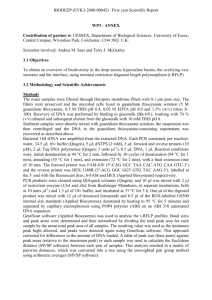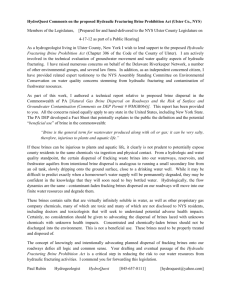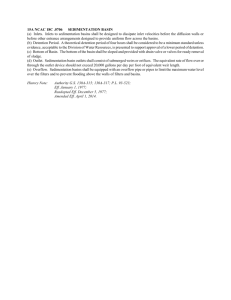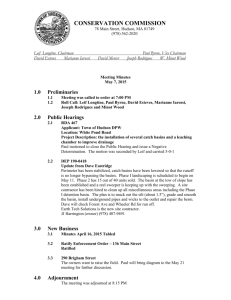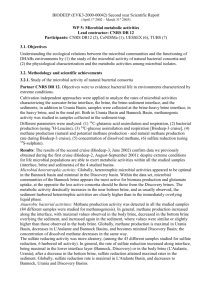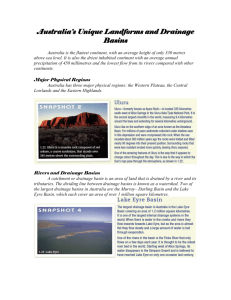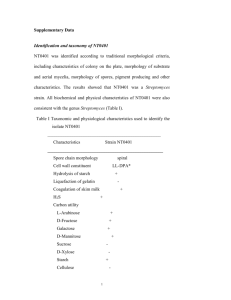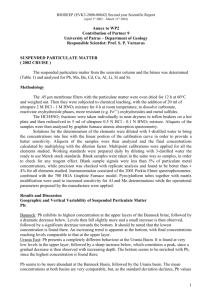WP3 – “ Analysis of the species diversity, community
advertisement
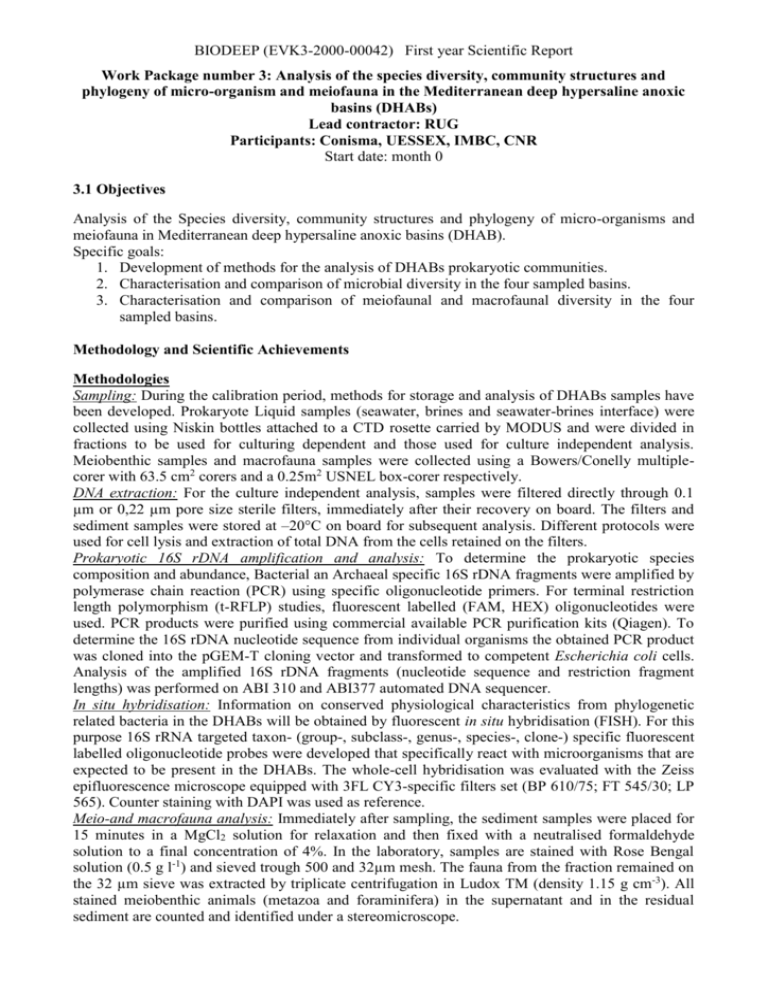
BIODEEP (EVK3-2000-00042) First year Scientific Report Work Package number 3: Analysis of the species diversity, community structures and phylogeny of micro-organism and meiofauna in the Mediterranean deep hypersaline anoxic basins (DHABs) Lead contractor: RUG Participants: Conisma, UESSEX, IMBC, CNR Start date: month 0 3.1 Objectives Analysis of the Species diversity, community structures and phylogeny of micro-organisms and meiofauna in Mediterranean deep hypersaline anoxic basins (DHAB). Specific goals: 1. Development of methods for the analysis of DHABs prokaryotic communities. 2. Characterisation and comparison of microbial diversity in the four sampled basins. 3. Characterisation and comparison of meiofaunal and macrofaunal diversity in the four sampled basins. Methodology and Scientific Achievements Methodologies Sampling: During the calibration period, methods for storage and analysis of DHABs samples have been developed. Prokaryote Liquid samples (seawater, brines and seawater-brines interface) were collected using Niskin bottles attached to a CTD rosette carried by MODUS and were divided in fractions to be used for culturing dependent and those used for culture independent analysis. Meiobenthic samples and macrofauna samples were collected using a Bowers/Conelly multiplecorer with 63.5 cm2 corers and a 0.25m2 USNEL box-corer respectively. DNA extraction: For the culture independent analysis, samples were filtered directly through 0.1 µm or 0,22 µm pore size sterile filters, immediately after their recovery on board. The filters and sediment samples were stored at –20°C on board for subsequent analysis. Different protocols were used for cell lysis and extraction of total DNA from the cells retained on the filters. Prokaryotic 16S rDNA amplification and analysis: To determine the prokaryotic species composition and abundance, Bacterial an Archaeal specific 16S rDNA fragments were amplified by polymerase chain reaction (PCR) using specific oligonucleotide primers. For terminal restriction length polymorphism (t-RFLP) studies, fluorescent labelled (FAM, HEX) oligonucleotides were used. PCR products were purified using commercial available PCR purification kits (Qiagen). To determine the 16S rDNA nucleotide sequence from individual organisms the obtained PCR product was cloned into the pGEM-T cloning vector and transformed to competent Escherichia coli cells. Analysis of the amplified 16S rDNA fragments (nucleotide sequence and restriction fragment lengths) was performed on ABI 310 and ABI377 automated DNA sequencer. In situ hybridisation: Information on conserved physiological characteristics from phylogenetic related bacteria in the DHABs will be obtained by fluorescent in situ hybridisation (FISH). For this purpose 16S rRNA targeted taxon- (group-, subclass-, genus-, species-, clone-) specific fluorescent labelled oligonucleotide probes were developed that specifically react with microorganisms that are expected to be present in the DHABs. The whole-cell hybridisation was evaluated with the Zeiss epifluorescence microscope equipped with 3FL CY3-specific filters set (BP 610/75; FT 545/30; LP 565). Counter staining with DAPI was used as reference. Meio-and macrofauna analysis: Immediately after sampling, the sediment samples were placed for 15 minutes in a MgCl2 solution for relaxation and then fixed with a neutralised formaldehyde solution to a final concentration of 4%. In the laboratory, samples are stained with Rose Bengal solution (0.5 g l-1) and sieved trough 500 and 32µm mesh. The fauna from the fraction remained on the 32 µm sieve was extracted by triplicate centrifugation in Ludox TM (density 1.15 g cm-3). All stained meiobenthic animals (metazoa and foraminifera) in the supernatant and in the residual sediment are counted and identified under a stereomicroscope. BIODEEP (EVK3-2000-00042) First year Scientific Report Scientific achievements during first year Partner 1c (CoNISMa) and 12 (CNR) counted microbial abundance by DAPI fluorescence staining and microscopy counting. Approximately 104 cells/ml were counted in the seawater column overlaying the brines, 106 cells/ml at the seawater-brine interface and 104-105 cells/ml in the brine bodies. For all brines measured, the interfaces are clearly enriched in microorganisms demonstrate that the chemocline between seawater and the brine pools acts as an in situ particle trap where microorganisms can flourish due to the increased concentration in available nutrients. Cell numbers in the Discovery brine body was found to be almost three orders of magnitude lower than in the other brines, which may be inherent to the divergent chemical composition in the Discovery basin. Partner 1c also determined the diversity in microbial communities in the 4 DHABs using various DNA-fingerprinting methods such as ITS-Homoduplex Heteroduplex Polymorphism (ITS-HHP), Automated Ribosomal Intergenic spacer analysis (ARISA), Amplified Ribosomal DNA Restriction Analysis (ARDRA) and Denaturing Gradient Gel Electrophoresis (DGGE). All the fingerprints showed that in the upper seawater column the bacterial pool is similar at all the depths analysed (1500, 2500 and 3300 m) and between the different areas (Discovery and Bannock). The brine pools showed to host bacterial communities different from the seawater, with high variability among the four basins sampled, suggesting that DHABs are environments with a relatively high biodiversity. Archaea in the brines are under investigation. Libraries constructed on a 150 bp fragment of the 16SrDNA gene, which include the V5 hypervariable region, have been screened for insert sequences. The retrieved clones will be compared with the total community diversity described by Single Strand Conformation Polymorphism (SSCP). At present, in Urania and L’Atalante brines sequences with partial homology to Halobacterium sp., Thermococcus sp., uncultured Euryarchaeota, unidentified Methanogen and other Archaea have been found. Partner 5 (RUG) focussed on the microbial community diversity by sequence analysis of the complete 16S rDNA genes of Bacteria and Archaea and on the presence of sulphate reducing bacteria (SRB) by screening for the conserved sulphite reductase gene. DNA extraction and PCR amplification of both archaeal and bacterial 16S rDNA was successful for all samples, demonstrating their presence in all samples. The sulphite reductase gene could only be amplified from brine and brine interface samples and not from the overlying water column. Sequence analysis was performed on a number of clones selected from 1500 bp long bacterial and archaeal 16S rDNA clone libraries obtained from the brine-interface samples. Sequencing of initial 700 bases (corresponding to position 700-1400 of the 16S rDNA gene of E. coli) from 96 bacterial 16S rDNA clones from the Discovery interface have been aligned and compared with the GenBank database using BLAST. 36 different bacterial species were identified (>97% similarity), indicating a high bacterial biodiversity. Dominant species found are Dechloromarinus chlorophilus (~99% similarity) and Thiomicrospira spp. (~97.5% similarity). 16 other sequences showed homology with sequences from other clones present in the database of GenBank (>95% similarity). Surprisingly, 64 out of the 96 clones had low sequence similarity (<95%) with sequences present in the GenBank database, indicating that the majority of the bacterial species present in the brine-interface of the Discovery basin are not yet cultured or sequenced. In addition, 16 sequences, although having a similarity below 97%, clustered within the groups of sulphate reducing bacteria showing that bacterial species play an important role in the sulphur cycle in this ecosystem. A preliminary comparison between the Discovery brine and the first 36 sequences obtained from the bacterial 16S rDNA gene of the L’Atalante brine interface showed in general a low homology. Sequencing of Archaeal 16S rDNA sequences are in progress. An initial survey revealed sequences homologous to know halotolerant or halophilic archaea or to uncultured archaea obtained from hypersaline lakes or deep-sea ecosystems but also sequences that have no match in the database. BIODEEP (EVK3-2000-00042) First year Scientific Report Partner 6 (UESSEX) was also successful in DNA extraction and 16S rDNA amplification from oxic seawater samples, interfaces and brines of L’Atalante, Urania and Bannock basins. Only samples obtained from Discovery basin yielded rather low molecular weight DNA or RNA only. The analysis of the restriction digestion of the PCR products revealed a relatively high similarity between the samples from oxic seawater overlaying the brines (Discovery at 2500 m and 3300 m depth and Bannock at 3000 m depth). Relatively high similarity was also observed between the deepest oxic seawater sample (3500 m depth near Discovery) and the Urania interface sample, and between the samples from l’Atalante and Bannock basin brines and l’Atalante basin interface. Urania basin brine has the most different microbial community on the basis of t-RFLP analysis. Partner 12 used the FISH technique to detect specific groups of microorganisms in the samples collected from the various brines. They observed a distribution of Archaea and Bacteria (FISH with CY3-labelled 16S rRNA oligonucleotide probes) within the sampled layers that was coherent with the DAPI counts since the ARCH + EUB bacterial counts were always corresponding to the 0.726.47% of the total prokaryotic density (TD). The experimental work pointed out a negative side effect of CY3-counter staining on the DAPI counts. In fact, in all double stained filters (DAPI+ either ARCH or EUB), the TD was decreased ten-fold. According to the TD values, the EUB vertical distribution showed a decrease from the upper to the lower interface of the basins followed by a significant increase in the Body Brine layer, with the exception of the Discovery basin Body Brine where no FISH signal was recorded. This suggests that the Body Brine environments of the L’Atalante, Urania and Bannock basins are much more suitable for Archaeal development than the Interface layers. Three 16S rRNA-targeted probes specific for halophilic bacterial taxa were optimised for in situ hybridisation. One of these three, the THT1 probe, was specifically designed to complement the 20A2530 clone sequence obtained from the L’Atalante Lower Interface which shows similarity to the Thermotoga group of Eubacteria. The THT1 probes matched with complementary sequences in all DHABs samples, with the exception of the Discovery Body Brine where no FISH signals were visualised. The highest THT1 FISH counts were recorded in the L’Atalante Upper Interface sample, where the THT1 signal covered about 15% of the total number of EUB cells. Analyses with the other two probes ARC94 (specific to the gram negative, aerotolerant bacterium Arcobacter ssp.) and HAB1 (specific to the strictly anaerobic and moderately halophilic bacterium Haloanaerobium spp.) are in progress. Partner 11, which is specialised in the meio- and macrofaunal diversity, found a rather low meiofaunal density from the non-brine sites of the L’Atalante, Urania and Bannock basins which ranged from 11.7 (Urania basin) to 26 ind. 10cm-2 (L’Atalante, MCAT03). At Discovery basin meiofaunal density was considerably higher (43.1 ind. 10cm-2). The brine samples of the L’Atalante and Discovery basins displayed higher densities compared to those from the non-brine sites (41.545.3 and 191.1 ind. 10cm-2 respectively). However, at Urania and Bannock basins the opposite trend was observed. In the normal non-brine sediment samples of the L’Atalante, Urania and Bannock basins nematodes were the most abundant taxon accounting for 44.7 to 64.4% of the total, followed by foraminifera (25 to 43.9 %). At the Discovery basin, foraminifera were the most abundant taxon (50.4%) followed by nematodes (40.9%), while at all basins, all the remaining meiobenthic taxa comprised less than 20 % of the total. Community structure in the brine sediments differed considerably among the four basins. At the Discovery basin the meiobenthos was dominated by copepods and foraminifera (mostly planktonic species) comprising 75% of the total, followed by juvenile bivalves, nematodes, allogromiid foraminifera, other crustacea. The L’Atalante basin was characterised by various meiofaunal taxa; nematodes, foraminifera, copepods, juvenile molluscs (unid. bivalves and gastropods). At the Urania basin juvenile bivalves (unid. sp.) dominated the community (61.5%) followed by copepods, foraminifera and other crustacean taxa. At the Bannock basin juvenile gastropods (unid. sp.) were the most abundant taxon (45%) at station MCBANN01, followed by the above-mentioned bivalves, nematodes, planktonic copepods and BIODEEP (EVK3-2000-00042) First year Scientific Report foraminifera. At station MCBANN02, the meiobenthos community was comprised of various taxa such as nematodes, foraminifera, crustacea and juvenile molluscs. Macrofaunal density values obtained from the non-brine sites of the Discovery and Urania basins range from 60 to 88 ind m-2 and are usual for deep-sea environments. In contrast to this, the corresponding value from the only brine site (Urania basin) available was much less (24 ind. m -2). The same trend was observed for biomass, with values ranging from 0.003-0.005 g m-2 outside the brines (Discovery, Urania), dropping to 0.001 inside the brine (Urania basin). Macrofaunal community structure is differs dramatically between the non-brine and brine sites. Polychaeta are dominant outside the brine sediments with values ranging from 62-73% and 59-90% of the total abundance and biomass respectively, while Crustacea, the second most dominant group, ranged from 20-38% and 6-39% of the total abundance and biomass respectively. In contrast, the brine site (Urania basin) is dominated by Crustacea (67% and 95% of the total abundance and biomass respectively). 3.3 Socio-economic Relevance and Policy Implication The result obtained so far already implies a large biodiversity with the majority of microbial species still being uncultured or unidentified. Because of this large novel biodiversity in this ecosystem, still unaffected by human interference, there is a reasonable change of finding new genetic or biochemical traits that might prove valuable for medical or biotechnological applications. 3.4 Discussion and Conclusions The total amount of microorganisms obtained from the samples seems to be sufficient for DNA isolation and PCR amplification to study the prokaryotic community structure by culture independent techniques. However for the culture dependent approach, larger sample sizes are essential and to be able to clone specific genes without amplification the amount of DNA obtained is probably insufficient. Unfortunately none of the partners in WP3 have been able to isolate DNA or amplify DNA fragments from the sediments samples even though several protocols have been applied. The reason is still unknown, but may be due to either a low cell density or the presence of factors inhibiting DNA isolation. Initial results already indicate large biodiversity with the majority of microbial species still being uncultured or unidentified. There seems to be divergence in the brine communities in which the l’Atalante and Bannock basins are more similar to each other than to the community inhabiting the Urania basin brine. This is reflected in the chemical composition of the brines, which is rather similar for l’Atalante and Bannock basins, whereas the Urania brine body is characterised by unique high sulphide and methane concentrations. The fingerprints from brine samples were less similar to each other than the oxic seawater samples A, C, and D from different depths and locations. The brines therefore have a microbial community unique to the respective location. 3.5 Plan and Objectives for the Next Period All of the partners within WP3 are now fully involved in their proposed research. Calibration of the essential techniques has been successful as well as the initial steps required for obtaining data (DNA-isolation, optimising FISH probes and fingerprinting techniques, etc.). Each partner will now focus on the analysis of the large amount of samples that were obtained during the cruise or were generated by DNA amplification or other techniques. Different, optimised DNA extraction protocols will have to be applied to the sediment samples to obtain microbial community profiles. These community profiles will be compared with those from anoxic enrichment cultures of sediment samples in order to determine whether enriched microorganisms are abundant in the sediments.
